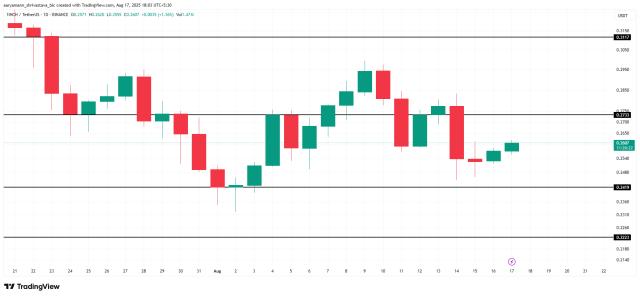Source: Digital Asset Research, compiled by Shaw Jinse Finance
Frankly, I've seen enough of the four-year cycle theory, so today I'm going to talk about why those who follow this theory will ultimately fail miserably.
These people have never studied time or cycles in their lives, yet they are certain that the four-year cycle will complete. They have no idea what they are dealing with and will ultimately be forced to buy at a higher price.
This is a pure data-based argument, not some random guesswork. I'm so fed up with the overwhelming pessimism and excessive caution in the market that it's making me very optimistic.
I don't mean to exaggerate what's going to happen to this market, but the sentiment alone is enough for me to say, "I've had enough of this nonsense. We're going to keep going up, and we're going to keep going up longer than these people can stay sane."
A bull market doesn't top when everyone is ready to take profits and walk away. It tops when people rush to leverage up their assets and mortgage their homes to buy more stocks. It tops when your simple-minded friend/neighbor/cousin/uncle makes a killing, far beyond their means, quits their job, and becomes an investment professional. It tops when no one, and I mean no one, is bearish anymore.
The situation today is very different from that time, when every time the S&P 500 fell 3%, investors fled the market; or the entire cryptocurrency world planned to sell off in the next three months because of some invented cycle that had no strong data support at all.
What these new cycle experts fail to realize is that a cycle is only as good as the underlying conditions under which it forms.
The saying “the map is not the territory” comes to mind at this point.
This means that while you can stare at a map endlessly, it only gives you a rough idea of where you are. It won't tell you that there's a huge pit 300 feet to your left. It won't tell you that there's a giant oak tree in the middle of a field. It won't tell you that there's an abandoned shack a mile ahead. And it certainly won't tell you that it's 110 degrees Fahrenheit outside with 50% humidity, or whether you're in a jungle or a deciduous forest.
A map shows the coordinates and direction of your location, but it doesn't give you a sense of the actual objects, surroundings, and terrain you might encounter while navigating.
A cycle is a map that provides us with time frames and historical data to give us a general idea of what we will typically see, but the conditions behind the market are the true reality.
These conditions determine whether the cycle becomes larger or smaller, whether volatility increases or decreases, and so on.
The conditions in the cycle we are in today are fundamentally different from the past three cycles, and we will examine why this is the case and how it is reflected in the charts. A key distinction here is the difference between saying "this time is different" and "it's the same old thing but different."
Price Structure and Behavior
From the very beginning of this cycle, it's clear that the market's structure and behavior differ from previous cycles. This is because new assets and markets go through different stages of growth and adoption. This reminds me of Peter Lynch's point about how corporate styles change over time.
Companies are not always high-growth companies. Over time, they transition to lower-growth companies that become the backbone of their industry.
This is a typical adoption cycle, where the first stage is hype, the second stage is growing pains and uncertainty, and the final stage is when mass adoption begins and the early majority of users begin to dominate.
Let’s look at the case of Amazon, including its life cycle and market structure, and compare it to Bitcoin and Ethereum.
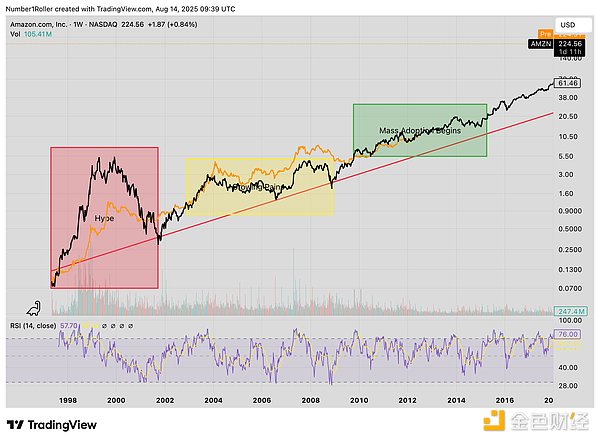
Similarly, ETH is as follows
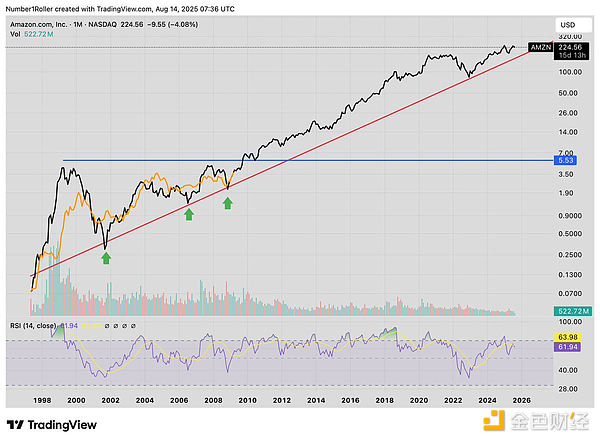
This is the argument we made during the market's first quarter plunge a few months ago.
We show a close correlation between Amazon (AMZN)’s current structure and behavior and what we are currently witnessing in major cryptocurrencies.
Clearly, the early 2017 cycle was driven by a lot of hype, similar to Amazon in 1999. The 2021 bull run, however, was more sideways in structure than a significant expansion. This will be a key test of whether the asset can survive the 2020 crash and 2022 bear market to prove its worth.
Likewise, Amazon (AMZN) didn't reach new all-time highs until after 2008. It had a long struggle to prove that it could survive the dot-com bust and that it could indeed build a viable long-term business.
Finally, we reach the mass adoption phase, where the early majority begins to join. This is the final hurdle facing Bitcoin and cryptocurrencies as an asset class. The final argument once raised—"What if the government bans it?"—no longer holds true. Far from banning it, governments are doing everything they can to embrace it. This is the classic adoption curve.
OK, that’s great, we know we’re in the mass adoption phase, but what does this have to do with the four-year cycle?
Dow Jones
Let's take a step back and look at the Dow Jones Industrial Average. The Dow Jones is undoubtedly any serious analyst's favorite chart, as its price history on Trading View goes back to 1896. With over 100 years of data, it's the best dataset we can rely on.
Looking back at the one-year chart of the Dow Jones Industrial Average, we can see three consolidations in its history that lasted more than ten years. The first two consolidations were followed by expansions lasting approximately 17 to 23 years. The most recent consolidation occurred from 2000 to 2013. The current rally has only lasted 16 years, which would be the shortest in history if it were a top.
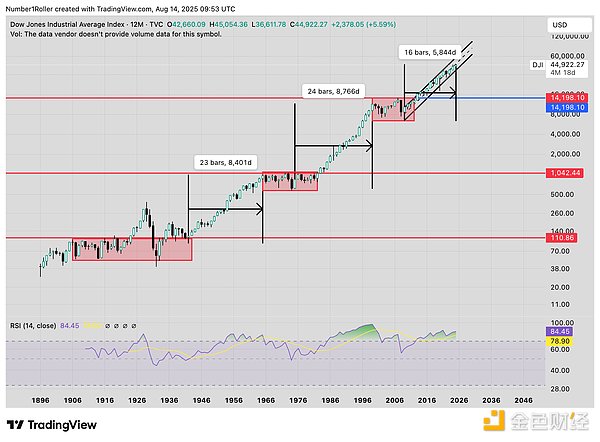
If we look closely at the 16-year bull market that began at the 2008 low, we can see that it retested the previous high four times.
The 2015 bottom was a retest of the 2008 top. The 2020 bottom was a retest of the 2015 top. The 2022 bottom was a retest of the 2020 top. And the most recent April bottom was a retest of the 2022 top.
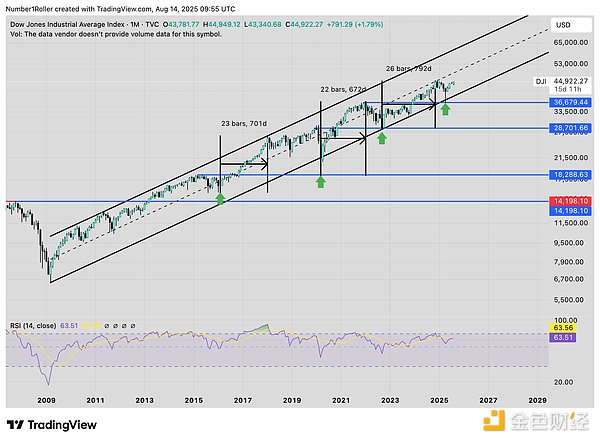
The market, like clockwork, continues to convert previous tops into support levels while continuing its upward trajectory. However, the key is the duration of the market's rally after each pullback. As shown in the chart above, the shortest uptrend is 22 months. Currently, we've only been up for five months since the April low. Using the shortest 22-month uptrend, the market would reach its peak in early 2027.
This is another great data point that shows you why I think the entire market is bullish for at least the next 12 months. In this environment, it is hard for me to believe that cryptocurrencies will crash while stocks continue to rise.
From bull market to bear market and then back to bull market
Another reason why I firmly believe that this bull market has just begun is the April crash.
I don't think people fully appreciate the level of panic that crash caused in both the stock and cryptocurrency markets. We're talking about sentiment, timing, and prices reaching severe bear market levels.
The readings we are seeing are comparable to the oversold levels and panic levels seen in 2020, 2008, and 2000. The market has completely collapsed.
This actually provides this market with the momentum it needs to kick-start a new bull run that will last longer and be stronger than anyone expected.
Consider the case of Ethereum (ETH). Ethereum's plunge lasted longer than the FTX crash, with a nearly identical price drop. In my view, this is the end of the bear market that began at the 2024 market top. We formed a triple top during the last rally in November, and the subsequent 50-plus-week bear market ended with that crash.

Supporting this view is the fact that Ethereum (ETH) has already experienced a full bull run. Typical bull runs last between 90 and 120 weeks. Subscribers are well aware of the importance of these timeframes.
Interestingly, it was exactly 90 weeks from the low in 2022 to the high in early 2024. In other words, I believe that was a complete cycle that quietly completed, followed by a bear market cycle that started from that high, lasted a full year (similar to other bear markets), and ended with a crash in April.
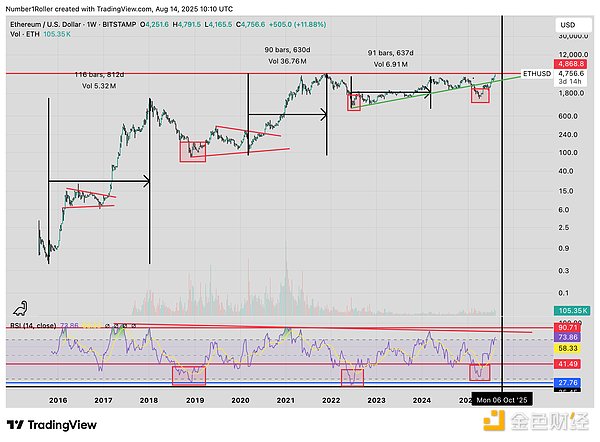
Just look at the Relative Strength Index (RSI) readings in the chart above. The weekly RSI has only reached these levels three times, and all three times were bear market bottoms. The April low is equivalent to a bear market bottom, which gives us plenty of room to move higher.
Copper/Gold Ratio
Here's a great market correlation chart provided to me by Bravos Research.
Here’s a chart of the Copper/Gold Ratio, which has consistently predicted Bitcoin’s parabolic moves and cycle tops since 2013.
Each time the chart bottomed out, Bitcoin began its most rapid expansion, and then, when it peaked, Bitcoin also continued to rise at higher levels.
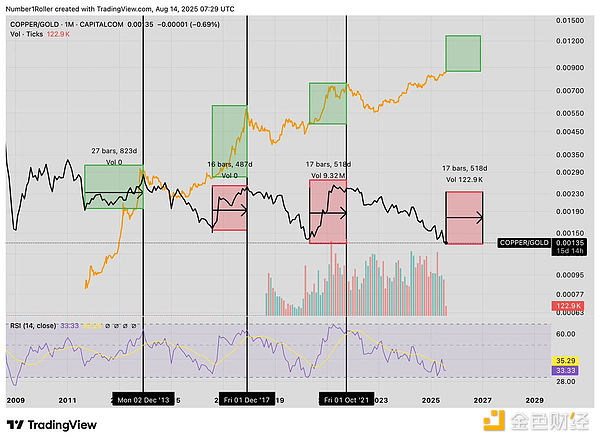
I find this chart interesting for two reasons. Besides the correlation (which is the clearest I've ever seen), the timing is also interesting. This chart is currently making a low, and assuming it is bottoming, the typical bull market cycle is 17 months.
Seventeen months from today, that is, by the beginning of 2027, this is consistent with what I just showed you for the Dow Jones Industrial Average.
Not only would it have continued rising for 17 months, but it would have coincided with the largest phase of Bitcoin’s bull run, which supposedly hasn’t even begun yet.
By the way, I want to show you data from Stansberry Research that highlights the short position in Bitcoin among traders' commitments.
We are currently the most bearish we have been since 2021.
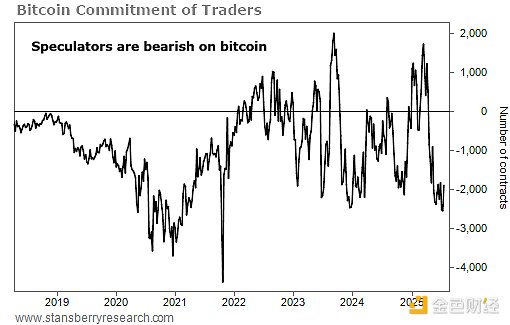
Stansberry’s data continues to show that every time the COT reaches a new extreme 1-year bearish level, subsequent price action follows.

This is only 6 years of data, but extrapolating from this, Bitcoin could surge to $230,000 by this time next year, again suggesting longer cycles based on this extreme reading.
Altcoin
Next up are Altcoin. I don't have much to say about Altcoin, except that I think the outlook for a major Altcoin market rally is very bright. However, large market moves take time, and as you can see, if these moves take time to play out, then the four-year cycle becomes meaningless.
Take a look at the “Other” chart below and if you find this bearish in any way, you can’t call yourself an analyst. Based on this structure alone, you can develop an extremely bullish outlook for Altcoin.
Furthermore, we know that the longer it takes for a market to break out of an old high, the more volatile its moves will be.
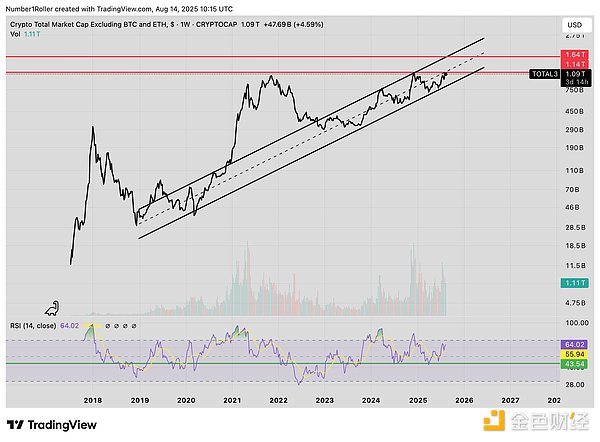
It's hard to say how far this situation will go once it breaks out, but I highly doubt it will be over in just eight weeks after nearly five years in the making.
From the comparison of TOTAL3 and BTC below, we can get a rough idea of the time required. Not only has it just started and has not yet broken through, but the usual operating cycle is 12 to 13 months, which means that we will not see the results until the second half of next year.
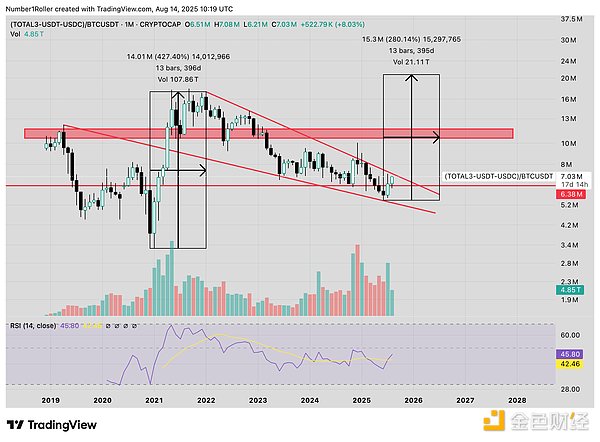
Then, taking a quick look at the overall "Other" chart, we see the same story, but over a longer timeframe. What's different about this recent bear market is that it's been going on longer than any other before. So when it breaks out, we should expect a significant rally, and more importantly, one that lasts a long time.
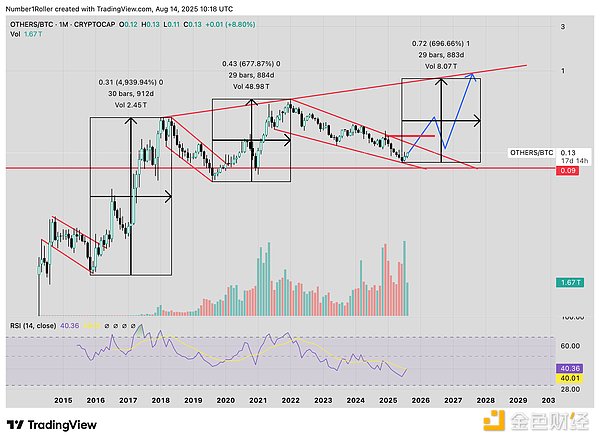
You can't analyze any of these charts and conclude that the breakout will be over in eight weeks. Based on these charts, we expect the rally to last 12 to 18 months.
Halving Theory
Finally, let’s talk about the halving theory, which, as I understand it, is the fundamental reason for the four-year cycle, right?
If the halving theory is correct, then why did we hit a new ATH before the 2024 halving? According to the theory, we should have hit a new ATH after the halving.
And why are we crashing in the first quarter of the fourth year of a four-year cycle? This has never happened before. But everything remains the same, right?
It seems to me that there are a lot of cracks already appearing, but these people are like bears in a bull market, refusing to give up and accept the facts.
Here’s a novel idea proposed by renowned BTC OG Adam Back, who was even quoted in the whitepaper.
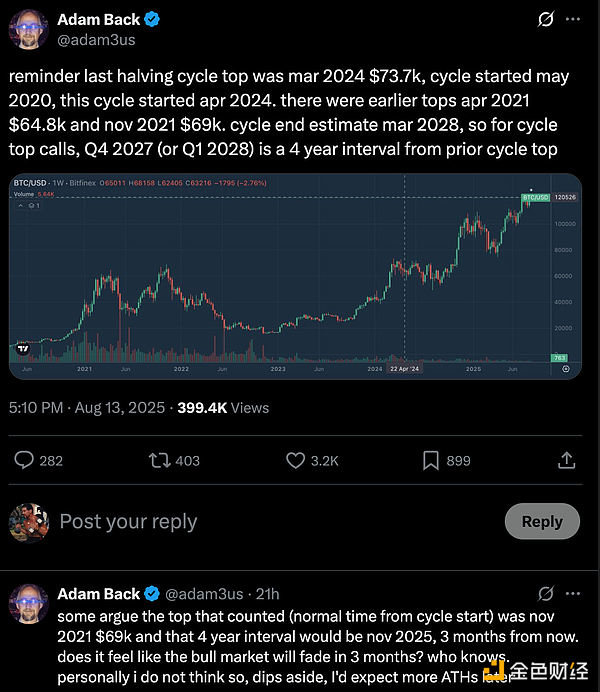
He noted that the cycle top is actually in April 2024 because technically that is the apex of the halving cycle, with the next halving cycle ending in mid-2028.
Interesting point, and a reasonable one in my opinion. This doesn’t mean there won’t be a pullback before 2028, or that 2028 is what I consider the cycle top target, it simply means the halving has virtually no impact on the price of Bitcoin.
Here’s a look at the Bitcoin halving and cycle tops
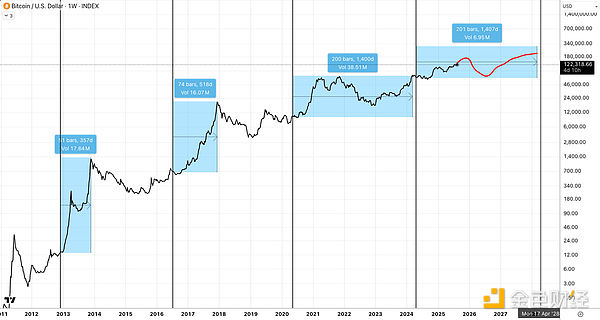
To sum up
That's certainly a bit of an exaggeration, but I do strongly believe that there's a ton of data that suggests this four-year cryptocurrency cycle isn't going away. The contrarian view is clear at this point, in my opinion, that both stocks and cryptocurrencies are set for a much larger and longer run.
While everyone is worried about the four-year cycle and overvaluation, I suggest taking a good look at the actual data and facts to support such concerns.
Any market veteran can tell you that current market sentiment is simply not strong enough to support a market top.
Too many people are ready to sell at a time when Ethereum has not yet set a new high and Altcoin are about to break out of a four-year consolidation range. However, judging by the Dow Jones Index and the copper-gold ratio, the market tells us that there is much more room for the market to rise than people think.
As I said on X the other day, long cycles are harder, not easier. And because people think we're still in the early stages, cycles won't last long because they'll make a killing. That's not the case. The longer the cycle, the more likely people are to lose money.
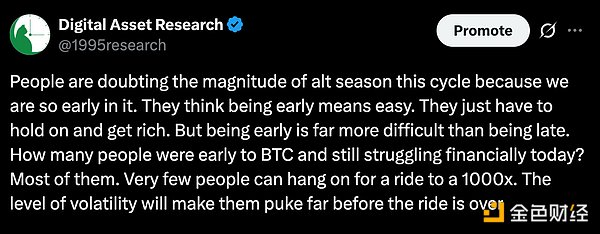
Not many people consider the fact that Ethereum did experience a complete bull run from its June 22nd low to its April 24th high, followed by a year-long bear market. Timing, price, and market sentiment all point to this being an accurate view, yet most people overlook this fact.
This wall of worry, fear, and doubt will continue to push this bull market to last far longer than anyone expects. The fact that most people are stuck in a four-year cycle is just adding more fuel to the fire.
Remember, the market will do whatever it can to deceive as many people as possible.
While we're entering a long bull market, that doesn't mean it will be smooth sailing. There will be dips, pullbacks, and corrections along the way that can be disorienting even the most seasoned investors. Having a framework for understanding market conditions is crucial to helping you find the right position so many investors strive to find.




